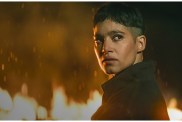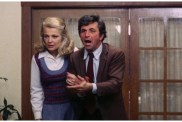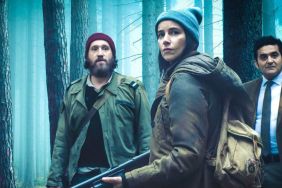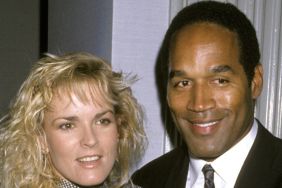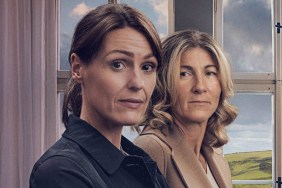
It was called Operation Pied Piper; a World War II exercise designed to move children at risk from aerial bombing raids during the 1940 London Blitz to areas where they would hopefully be out of harms way. But for a group of schoolchildren evacuated with their teachers to Eel Marsh House, safety remains a key issue. For the derelict estate, cut off by a tidal causeway from the mainland, is home to the terrifying spectre known by local legend as The Woman in Black. And that harbinger of doom returns in the continuation to the most profitable British horror film ever released.
Talk of The Woman in Black 2: Angel of Death started while Hammer CEO Simon Oakes was overseeing post-production on the James Watkns-directed original. Oakes recalls, It was clear to us all that The Woman in Black was going to be a highly commercial movie, quite how successful it did become was a total surprise. But although accused of hubris by certain people I started putting plans in motion for a sequel very early on. I knew it had to have novelist Susan Hills name on it again for credibility reasons, so I went to see her and asked if she would be interested in writing a new story because I was convinced we had a hit on our hands. It turned out she wasnt interested in doing that, but was fully prepared to give us her blessing and an approved through-line that would continue her connection with the property. Her inspiration for the basic concept came from driving through the county of Norfolk where she did her writing and passing overgrown airfields from the Second World War. It was the thought of ghostly airplane crew that got her creative juices flowing; what if Eel Marsh House had fallen into disrepair after Arthur Kipps (the Daniel Radcliffe character) met his fate and the desolate place was waiting to be reoccupied?
Producer Ben Holden picks up the genesis explanation: From Susans ideas we pulled an outline together and then got writer Jon Croker involved. Jon had been story editor on a variety of genre moviesAttack the Block, Berberian Sound Studio, In Fearand he finessed her war period concept with the evacuated children thread and the whole brainwave about them supposedly being safer shipped off to the English countryside when in fact the reverse is true and they are placed in even more terrifying danger. Susans coup-de-cinema was always the house at the end of the causeway visuals and The Woman in Black silhouette and we knew those elements had to be placed well in any continuation. We felt Jon reinvigorated those elements in new ways to freshly extend the supernatural myth. The Woman in Black set the bar pretty high so we had to not only maintain that quality but also balance it with further non-corporeal innovation. Jon seeing The Woman in Black in spooky Mrs. Danvers (from Daphne Du Mauriers novel Rebecca) terms was a masterstroke.
But who would direct The Woman in Black 2? James Watkins wanted to move on to pastures new (The Loch, Bastille Day), so Oakes and Holden began searching for up-and-coming British talent. Holden points out, British genre guys dont grow on trees and we needed someone with a good head for story content and drama, with a keen eye for visuals and who could nail the scares. Hammer has always been about making you care for the characters or the response to the plot will be diluted, so we had to ensure whoever we chose had a film grip on that dynamic. The first film revolved around one mans loss and the comfort of an afterlife. Sure, children were in jeopardy too but that was more of an adjunct to the central focus on Kipps. The children in danger thread has a totally different vibrancy in Angel of Death, which comprises of three characters reaching an entwined catharsis against The Woman in Blacks back story.
Oakes continues, Tom Harper came in and pitched off a treatment we had prepared and we took note because one of his mentors was Tessa Ross, the executive head of drama at Channel 4 and Film 4. Tessa is a good judge and Tom had directed the Demons miniseries and The Scouting Book for Boys, which proved he knew his way around suspense. We were all impressed by his energy, enthusiasm and reputation for attracting great actors with his material. He was the front runner from the start in a very narrow field and once we put Tom together with Jon to discuss the script, we knew we had made the right choice.
Known in Great Britain for directing episodes of the TV series This is England, Misfits and Peaky Blinders, Tom Harper remains convinced it was his lucid ideas on what he wanted to achieve with Angel of Death that swung him the Hammer gig. He explains, I was clear about why I liked The Woman in Blacka premium placed on eeriness, suspense and forebodingbut even clearer on the fact I would inject more psychological horror and creepy atmosphere into the continuation. I wanted to create a specific world where the audience would be put into the tensest of places, where a doorknob turns, cranking up the anxiety, the darkness in the rooms enveloping you The first film was quite theatrical in approach too and I wanted to make a Part 2 more organic so the threats felt very real. Ive broadened the scope of the walk along the misty causeway, the underwater sequences and the woods scenarios while expanding on the central Woman in Black themes of abject loss. Of course you have to give an audience what they want based on the massive success of the first film, but by tweaking the familiar in unusual ways I believe Ive made the heightened reality aspects even more relevant to a contemporary audience. And how fantastic to now be a part of the Hammer tradition, a brand I grew up with. It was a total pleasure working for a company that means so much to horror fans and also in film heritage terms.

All the events in Angel of Death are seen through the eyes of the young and beautiful schoolteacher Eve Parkins, who must confront the demons in her past to survive the curse of The Woman in Black. That pivotal role is played by relative newcomer Phoebe Fox, given a Star of Tomorrow accolade by trade magazine Screen International, who Harper cast early on in pre-production based on her stunning audition tape. Fox says, But the start date for Angel of Death kept getting pushed back so Tom gave me a lead role in his post-apocalyptic political drama War Book. It was a clever move on his part because we got used to each others working methods before beginning such a high profile movie for us both. Whereas the first film was centred on Daniel Radcliffe, the action here is driven by a female protagonist with a dark past, so its not just about Eve defeating a scary ghost. Theres a very heartfelt and human dimension to the plot. Shooting continuously in a cold November/December (of 2013) was difficult; 12-hour days of being thrown down cliffs, freezing in the sea, nearly drowning and getting an eye-infection from three days floating in a water tank. But Im starring in the follow-up to a mega-successful movie so I cant really complain.
On the train journey to Eel Marsh House with her adolescent wards, Eve meets the dashing RAF pilot Harry Burnstow who becomes an increasingly important part in her life as the horrors unfold. That handsome hero is played by Jeremy Irvine, star of War Horse and The Railway Man, adding yet another war story to his résumé with Angel of Death. Irvine observes, Nine out of ten scripts I get sent dont engage or move you. This one did and I was still thinking about it for days afterwards as it left me tingling. I wasnt looking to make a horror film particularly, but this stood up as a strong, classy story apart from all the scary moments. Without spoiling anything Harry is lying all the way through the action pretending to be something he isnt and that was a great foundation to essay a three-dimensional character with a terrific back story. Toms directing discipline reminded me of Steven Spielbergs on War Horse because he knows what he wants, shoots economically, confidently moves things along, is quiet about it but exudes the authority necessary to keep everything under control. It sounds incredibly childish but my favorite scenes had me riding a vintage 1941 motorbike up and down the causeway. I adored doing that and the fact that Ive now become a bona fide Hammer Hero.

Playing headmistress Jean Hogg who tries to keep calm and carry on while supernatural events conspire against her is acclaimed British actress Helen McCrory, Narcissa Malfoy in the Harry Potter franchise, Madame Kali in Penny Dreadful and real-life wife of Homeland star Damian Lewis. She states, I appeared in the Peaky Blinders series and when Tom directed a couple of episodes he mentioned hed been offered Angel of Death and said hed like me to be in it. Naturally I was flattered, even though I dont really like horror films because being scared is not a sensation I enjoy. But I saw this as a dark fairytale and Jean Hogg was a dream character to playtypically English, stiff upper lip, army background and coping against all the odds because, well, you have to dont you. My challenge was to take someone easy to laugh at because shes such a cliché and make her command respect and sympathy.
She adds, What has been extraordinary about being a part of Angel of Death is the long tradition it encapsulates. Im not kidding when I say that weve had three generations crewing on it and their relatives who worked on the original Hammer Dracula and Frankenstein series have all visited us on the Pinewood Studio sets. Amazing and humbling and the reason why I decided to make my Hammer House of Horror Scream a very special one indeed, in keeping with such past stars as Barbara Shelley and Ingrid Pitt. Not only did I practice every day, I had a tooth filling changed from zinc amalgam to pure white so you wont be distracted when the camera moves in for a close-up. Thats how dedicated I am to what everyone will hopefully consider a worthy follow-up to the original record-breaker.

